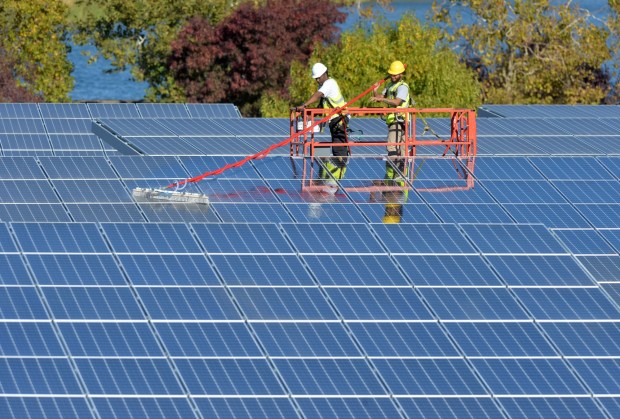Rooftop-solar businesses in the Bay Area are reeling from a statewide change that gutted compensation for homeowners returning surplus power to the electrical grid.
Sales of rooftop-solar setups have plummeted about 80% since the California Public Utilities Commission shrank by 75% the compensation new solar owners get for surplus power, the California Solar and Storage Association said. The shift has caused applications for new solar panels to plunge to a 10-year low.
The group estimates that 2,700 jobs have been lost in the Bay Area and 17,000 statewide. About 2 million California homes have solar, according to the association.
“So many businesses are struggling to keep their doors open,” said Bernadette Del Chiaro, the association’s executive director.
In lower-income areas of Northern California and the Central Valley, the effects are more severe than in the wealthier Bay Area, Del Chiaro said. Still, solar company owners in this region described major fallout.
Owners of residential solar systems had been receiving enough utility credits to pay for most systems in seven years, industry representatives said, but for systems ordered after April 15, 2023, it will take 11 years. Residents with systems predating the change will continue to receive the same compensation.
Under the new formula, the average solar owner loses out on about $1,200 a year in savings, Del Chiaro said.
In Marin County, the number of solar installation permits appears to have remained steady, but sales have dropped dramatically, according to a statewide database, said Dana Armanino, sustainability planning manager for the Marin County Community Development Agency.
In 2022, for example, the data show there were about 170 applications for interconnections each month in Marin, Armanino said. After the change took effect in April, that went down to about 32 per month, she said.
“So that’s a very significant drop in projects,” Armanino said. “What I glean from that is actual installs are still going on for the residual of projects sold before April. There appears to be some lagging numbers, and some of that is maybe the contractors sold so many projects before the change in rates and got busy installing.”
Phil Alwitt, chief executive officer of SolarCraft in Novato, said that is consistent with what his business is experiencing.
“Our pipeline of current work is excellent, with installations ready to go for the remainder of 2024 for both residential and commercial,” Alwitt said.
SolarCraft has seen a drop in sales since the compensation change, but Alwitt said he wants to stress that the economics are still good for customers, despite negative reports.
“Part of that is due to PG&E rates increasing so much it enables solar to be a great investment with a very quick payback,” Alwitt said.
Starting this month, electricity bills for the typical PG&E customer are expected to average roughly $222 a month. That’s 28.4% higher than the monthly electricity bill of $172.84 last January.
Gas bills are slated to average $72 a month starting in early 2024. That’s 6.1% higher than the average monthly gas bill of $67.89 in January 2023.
State data show solar applications in PG&E’s service area climbing steadily from June 2020, spiking abruptly after the commission’s December announcement of the compensation cut, then plunging after April to levels not seen since 2014, other than in two months of pandemic shutdowns in 2020.
Some Bay Area businesses are feeling the effect.
“They clobbered the economics,” said Barry Cinnamon, owner of Cinnamon Energy Systems, a rooftop-solar company in Los Gatos.
Cinnamon said his sales fell more than 50%, and many orders were for smaller systems.
“Low- and middle-income people are really incapable of affording solar now,” he said.
California households with median incomes of $50,000 to $100,000 have long had the highest rates of solar installation, although Bay Area solar adopters skew wealthier, according to Lawrence Berkeley National Laboratory data.
Critics claim that millions of dollars in political donations to Gov. Gavin Newsom from PG&E and powerful electrical workers unions influenced his appointments to the California Public Utilities Commission, whose decisions are making rooftop solar costlier for consumers and industrial-scale solar more lucrative for investor-owned PG&E. And as the utility’s rates surge, its government allies have made it harder for residents to generate their own household power — or to help fight climate change by switching to electric cars and home heat pumps, the critics contend.
In a Dec. 13 blog post, PG&E crowed about record applications for solar power making 2023 a “historic year.” The utility noted an “unprecedented volume” of applications in January through April, between the announcement of the compensation cut and its implementation. Absent from the post is what happened after the cut took effect in April.
PG&E, in a statement, described criticism that it is obstructing rooftop solar as “blatantly false,” and said it has connected more than 700,000 systems.
Central to the criticism of PG&E is the guaranteed 10% to 12% profit it is allowed to make, via rate increases, on its investments in infrastructure including systems for feeding power to urban areas from large remote solar arrays.
“That’s crazy high,” said Del Chiaro. “It sets up this incentive for them to be against anything that reduces the need for poles and wires.”
Newsom’s office declined to comment.
Critics of the cut see further machinations in a 2016 agreement between PG&E and the International Brotherhood of Electrical Workers — whose members build large-scale power-delivery infrastructure — that said “changing energy policies and competition” in California meant the utility and union should work together in the face of broadening customer choices.
Scott Wetch, a lobbyist for the union, said claims that its political activism had a “disproportionate impact” on the commission’s decision to slash compensation ignored broad support for the cut among some environmentalists and ratepayer advocates.
The California Court of Appeal, in upholding the cut on Dec. 20, described the previous compensation formula as “an economically unwarranted subsidy” for homeowners with solar, paid for by utility fees from those without. The value of compensation varies widely depending on time of day and time of year.
Bubbling beneath the dispute over residential solar is a bitter battle dividing environmental groups over whether combating climate change requires sacrificing pristine — but ideal for solar generation — desert wilderness like the Mojave Desert. Critics say California’s solar development has become tilted heavily in favor of environmentally damaging industrial-scale solar projects while kneecapping the rooftop generation crucial to getting the state off fossil fuels quickly.
“We’re plowing those ecosystems under for solar developments affecting desert tortoises and kit foxes and bighorn sheep,” said Dustin Mulvaney, an environmental studies professor at San Jose State University who has testified before Congress three times in the past two years about solar power and electricity storage. “We have a biodiversity crisis and a climate crisis and I think rooftop solar is really a perfect way to address both.”
To make meaningful progress against climate change, and shut down climate-damaging natural gas power plants that still provide 36% of the state’s electricity, California needs solar on every viable roof, parking lot and canal, and it also needs big arrays in less-sensitive sites including the state’s tens of thousands of square miles of hazardous-waste sites, abandoned dumps and mines, Mulvaney said.
“Cutting the California solar industry by half clearly hurts efforts to reduce climate change,” said Bill Carney, chair of Sustainable San Rafael, an environmental advocacy group. “The PUC and the Legislature need to go back to the drawing board and rethink how we could shift to a renewable and reliable grid.”
Carney says that means battery storage to homes.
Solar industry representatives highlight the $5,000 to $10,000 additional cost of putting batteries on a typical $15,000 rooftop solar setup. But they acknowledge, as Cinnamon said, that since the payback cut, adding capability to store power generated during the day has become “essential” for cutting electricity bills.
The utilities commission, responding to criticism of the cut, highlighted a move to battery systems, saying it was “actively steering California” toward a “thriving” market for rooftop solar with batteries.
Del Chiaro said battery attachment rates have gone up, but with fewer new solar installations, any progress will be limited.
Former San Jose Mayor Sam Liccardo, a rooftop-solar advocate now running as a Democrat to represent Silicon Valley in the U.S. House of Representatives, said incentives, possibly including new federal loan programs, would help put “batteries in every garage.”
Marin IJ reporter Adrian Rodriguez and Bay Area News Group data reporter Harriet Blair Rowan contributed to this report.
This post was originally published on 3rd party site mentioned in the title of this site





